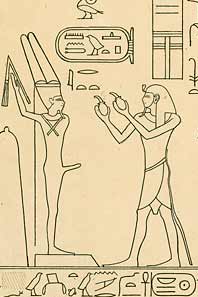Mentuhotep IV
| Mentuhotep IV | |||||||||||||||||||||||||||||||||||||||||||||||||||||||||||||||||||||||||||||||||||||||||||||||||||||||
|---|---|---|---|---|---|---|---|---|---|---|---|---|---|---|---|---|---|---|---|---|---|---|---|---|---|---|---|---|---|---|---|---|---|---|---|---|---|---|---|---|---|---|---|---|---|---|---|---|---|---|---|---|---|---|---|---|---|---|---|---|---|---|---|---|---|---|---|---|---|---|---|---|---|---|---|---|---|---|---|---|---|---|---|---|---|---|---|---|---|---|---|---|---|---|---|---|---|---|---|---|---|---|---|
 Mentuhotep IV (right) gives offerings to Min. From Wadi Hammamat | |||||||||||||||||||||||||||||||||||||||||||||||||||||||||||||||||||||||||||||||||||||||||||||||||||||||
| Pharaoh | |||||||||||||||||||||||||||||||||||||||||||||||||||||||||||||||||||||||||||||||||||||||||||||||||||||||
| Reign | 1997–1991 BC[1] | ||||||||||||||||||||||||||||||||||||||||||||||||||||||||||||||||||||||||||||||||||||||||||||||||||||||
| Predecessor | Mentuhotep III | ||||||||||||||||||||||||||||||||||||||||||||||||||||||||||||||||||||||||||||||||||||||||||||||||||||||
| Successor | Amenemhat I | ||||||||||||||||||||||||||||||||||||||||||||||||||||||||||||||||||||||||||||||||||||||||||||||||||||||
| |||||||||||||||||||||||||||||||||||||||||||||||||||||||||||||||||||||||||||||||||||||||||||||||||||||||
| Mother | Imi (King's Mother) | ||||||||||||||||||||||||||||||||||||||||||||||||||||||||||||||||||||||||||||||||||||||||||||||||||||||
| Died | 1991 BC | ||||||||||||||||||||||||||||||||||||||||||||||||||||||||||||||||||||||||||||||||||||||||||||||||||||||
| Dynasty | 11th dynasty | ||||||||||||||||||||||||||||||||||||||||||||||||||||||||||||||||||||||||||||||||||||||||||||||||||||||
Nebtawyre Mentuhotep IV was the last king of the
Family
King's Mother Imi
In Wadi Hammamat, a rock inscription (Hammamat M 191) with the royal name of Mentuhotep IV also mentions King's Mother Imi.[5] This monument only focus on the title King's Mother, presumably the mother of Mentuhotep IV. It does not include other titles like King's Wife, King's Sister or King's Daughter. Some have speculated that she was a concubine in the royal harem.
Mentuhotep III or Mentuhotep II
It is not certain who the father of Mentuhotep IV was. Most scholars suggest that he was the son and successor of Mentuhotep III. However, it is also possible that he was a son of Mentuhotep II, thus a brother or half-brother of Mentuhotep III. The fact that he has been omitted from several king lists indicate that there was a crisis in the order of succession. He also represents the last king of the eleventh dynasty, and his reign is poorly documented indicating turmoil.
Rock inscriptions
He is known from several inscriptions at several locations, despite his reign being omitted from the
Wadi el-Hudi
Also, he is attested by the inscriptions at Wadi el-Hudi.[6]
- Wadi el-Hudi 1 dated to Year 1
- Wadi el-Hudi 2 dated to Year 1
- Wadi el-Hudi 3 dated to Year 1
- Wadi el-Hudi 4 dated to Year 1
Ain Sukhna
At the Red Sea port of
Year 1, arrival of the king’s men; workforce: 3000, to bring back turquoise, copper,3 bronze (?) and all fine products of the desert.[8] [rnpt-zp 1: jwt mšʿ n nswt; ṯnw n mšʿ pn 3000 n s r jnt mfkȝt, bjȝ, ḥsmn (?), jnw nb(w) nfr(w) n ḫȝst]
Wadi Hammamat (Eastern Desert)
He is known from a few inscriptions in
- Hammamat G 52
- Hammamat G 53
- Hammamat G 54 dated to Year 2
- Hammamat G 55
- Hammamat G 56
- Hammamat G 57 dated to Year 2
- Hammamat G 58
- Hammamat G 59
- Hammamat G 60
- Hammamat G 73
- Hammamat G 140
- Hammamat M 1
- Hammamat M 40
- Hammamat M 55
- Hammamat M 105
- Hammamat M 110 dated to Year 2 by Vizier Amenemhat {jrj-pꜥt; jmj-rꜣ njwt; ṯꜣtj; jmj-rꜣ kꜣt nsw n mḥ-jb jmn-m-ḥꜣt}
- Hammamat M 113 dated to Year 2 by Vizier Amenemhat {jrj-pꜥt; jmj-rꜣ njwt; ṯꜣtj; jmj-rꜣ kꜣt nsw n mḥ-jb jmn-m-ḥꜣt}
- Hammamat M 191
- Hammamat M 192 dated to Year 2 by Vizier Amenemhat {jrj-pꜥt; jmj-rꜣ njwt; ṯꜣtj; jmj-rꜣ kꜣt nsw n mḥ-jb jmn-m-ḥꜣt}
- Hammamat M 205 by Vizier Amenemhat {jrj-pꜥt; jmj-rꜣ njwt; ṯꜣtj jmn-m-ḥꜣt}
- Hammamat M 241
Other attestations
A fragment of a slate bowl found at Lisht North was regarded for a long time to be inscribed on the outside with the official titulary of Mentuhotep IV, and on the inside with that of King Amenemhat I, his successor. Since the two inscriptions are incised in a different style of writing, according to Dorothea Arnold, this indicates that Amenemhat had his name added to an older vessel that already bore the name of Mentuhotep IV.[9] However, Peter Janosi showed that Mentuhotep IV is not mentioned on the bowl, the titulary preserved there fits better to Mentuhotep II.[10]
End of reign
It is assumed by some Egyptologists that Amenemhat either usurped the throne or assumed power after Mentuhotep IV died childless. There is currently no archaeological or textual evidence to prove that Mentuhotep was deposed by his vizier or that he chose Amenemhat to be his designated successor. Neither his
See also
References
- ISBN 0-7864-2562-8.
- ^ Mentuhotep IV's titulary on Eglyphica.de
- ^ King List (chronological)
- ISBN 0-500-28628-0
- ^ "Hammamat M 191 | Persons and Names of the Middle Kingdom".
- ^ Fakhry, Ahmed (1952). The Inscriptions of the Amethyst Quarries at Wadi el Hudi.
- ISBN 9782724703221.
- ^ Mahmoud Abd el-Raziq, Georges Castel, Pierre Tallet, Grégory Marouard (2012) The Pharaonic Site of Ayn Soukhna in the Gulf of Suez 2001-2009 Progress Report
- ^ Dorothea Arnold, Amenemhat I and the Early Twelfth Dynasty at Thebes. Metropolitan Museum Journal, v. 26 (1991)
- S2CID 192546924.
Further reading
- Grajetzki, Wolfram (2006-02-24). The Middle Kingdom of Ancient Egypt: History, Archaeology and Society. pp. 25–26. ISBN 9780715634356.

